I argue that mastering one practical lap steel tuning before collecting others accelerates musical fluency — not from dogma but from pragmatic observation of what actually works in practice. I’ve spent years experimenting with lap steel tuning in practice rooms, recording sessions and teaching beginners, and I use a focused approach when orienting new players. This short, hands-on tuning guide lays out how to tune lap steel step-by-step, explains common lap steel tunings (C6, A6, Open G/D, D6) and the real trade-offs I’ve seen between playability, range and genre fit. I’ll give clear, practical advice for tuning for beginners, show when to pick each tuning, and cover essential setup choices so your instrument responds on stage and in the studio. Read on for a compact, experience-driven roadmap: the how-to basics you need now, the reasons behind each choice, and the simple next steps I recommend to get musical results quickly without needless complexity. Start with one tuning and expand deliberately later.
Who: Who Plays Which Tunings?
Genres & Players (Hawaiian, Country, Jazz)
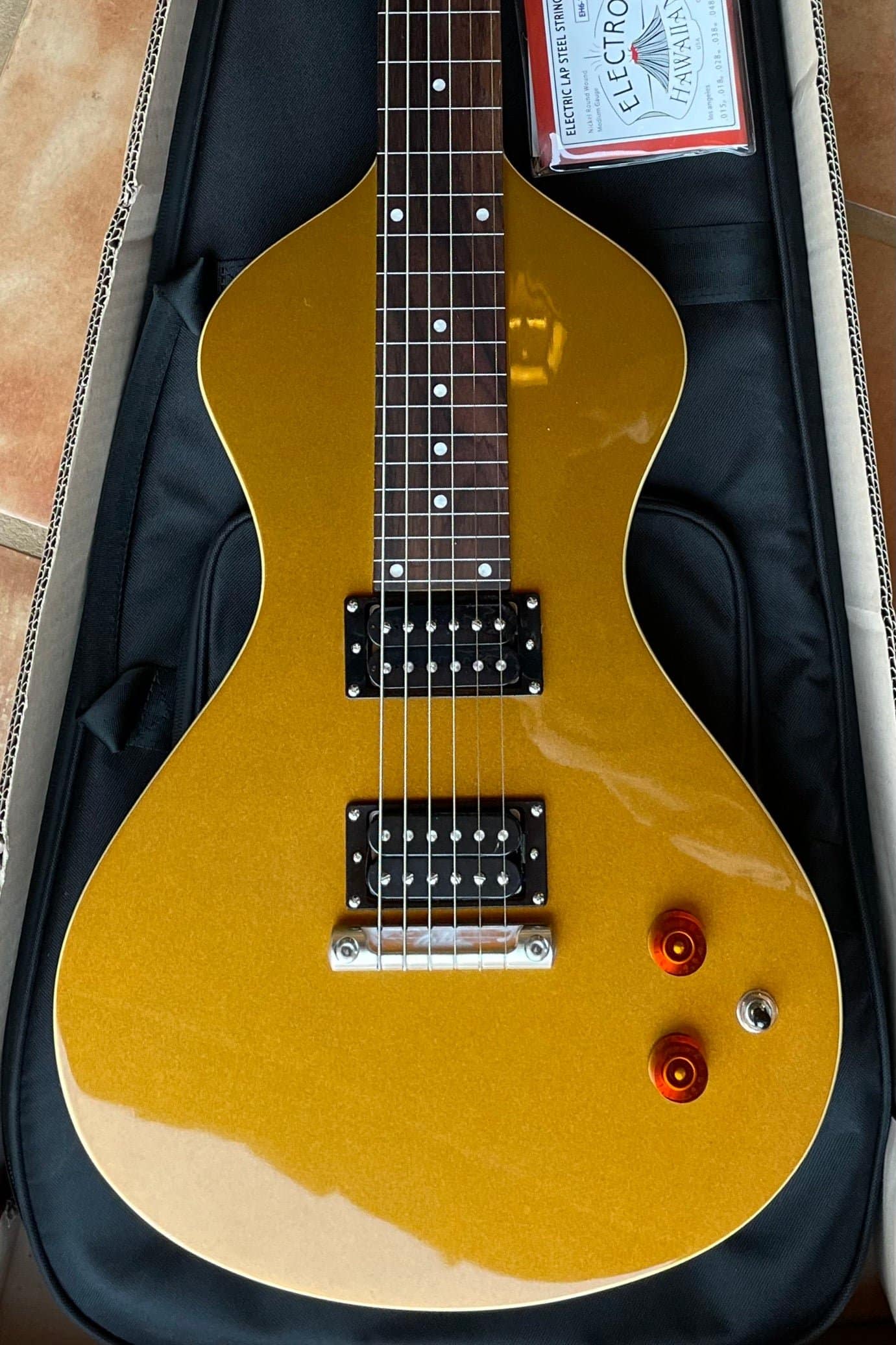
I’ve toured with Hawaiian-style players and played with country steel veterans — I condense tonal preferences in ‘Who’ for context. A Hawaiian lap steel tone isn’t just a tuning — it’s a cultural and stylistic choice that dictates phrasing and technique. In my experience, Hawaiian lap steel tuning (often C6 variations) prioritizes rich major-six voicings and open-string harmonics; it’s ideal for lyrical lines but can limit raw blues bends.
For country, tuning for country steel (A6, E7-derived) favors pedal-like licks and ease of double-stops, though it demands precise bar technique and extra necks. Jazz players lean toward tuning for jazz lap steel (extended C6/A6 voicings) to access complex chords at the cost of simpler open-string drones. Bottleneck tuning and open G/D remain practical alternatives when simple slide phrasing is needed.
Player Types & Instruments (6/8 string, necks)

Having set up 6-, 8- and double-neck steels for students and studio players, I outline how instrument choice narrows or widens tuning options. Is more necks and more strings always better — or does the choice of instrument define the tuning you’ll actually use?
In my experience, beginners and solo players lean toward a single 6-string lap steel tuning for simplicity and focused learning; standard lap steel tuning choices stay practical there. Professional sidemen and jazz players often prefer 8-string lap steel tuning for richer voicings, while session players use double neck lap steel tuning or triple neck tuning to switch C6 and A6 easily. That flexibility comes at cost—weight, setup complexity and string-gauge compromises. I weigh trade-offs so readers practically know who should pick which instrument and why.
What: What Are Common Tunings and Concepts?
Overview of Common Tunings (C6, A6, Open G/D, D6)

I’ve distilled the ‘what’ of common lap steel tunings into a shortlist. From teaching beginners to arranging for bands, I’ve found a handful of tunings cover most practical needs — this overview is the result of that curve of experience. One small set of tunings handles most lap steel jobs — here’s the shortlist every player should know. I outline C6 tuning and A6 tuning for rich chords, jazz and Hawaiian voices, noting C6’s wider chord palette while A6 can favor lead voicings but may restrict low bass options. I cover Open G tuning and Open D tuning as slide- and drone-friendly choices that trade chordal complexity for immediacy. I close with D6 tuning’s sweet major-sixth colors and situational limits. This is a practical “what” map — what each tuning gives you, and what it asks of your technique and instrument.
Other Tuning Types & Acoustic Variants

I’ve experimented with slack key tuning, resophonic tuning and Weissenborn tuning; section captures useful acoustic alternatives you can try alongside electric staples. Beyond C6 and Open G lies a world of regional and acoustic tunings that can reshape your approach to melody and comping.
What are they? In practice, slack key tuning and Hawaiian lap steel tuning prize open, droning intervals that favor finger-style phrasing and resonant overtones. Resophonic tuning and Weissenborn tuning emphasize acoustic projection and sympathetic sustain but often demand different instrument types, action and string gauges. Open tunings trade chordal ease for modal color; they can limit chromatic options without retuning or extra strings.
I present these as practical alternatives within the ‘What’ category: clear, sonically distinct choices with trade-offs you should weigh before adopting them. I recommend trying acoustic tunings at a time to assess suitability.
When: When to Use Each Tuning?
Song & Genre Contexts (When C6 or A6 Fits)

I’ve used C6 tuning and A6 tuning across Hawaiian standards, country ballads (tuning for country steel) and jazz charts in studio contexts; belongs under When: When to Use Each Tuning?. C6 or A6? The deciding factor is rarely theory — it’s the song’s voicing needs and the player’s role in the arrangement.
I favor C6 for wide chordal palettes, pedal-less harmony and vintage Hawaiian textures, but it can crowd melodic single-note lines. A6 often wins when I need guitar-like major-sixth colors, compact lead shapes and easier doubling in band mixes, though it sacrifices some low-end reach. Practically, choose by role: layering rhythm or filling harmonic gaps suggests C6; concise melodic comping or tuning for jazz lap steel points to A6. Consider retuning time, string count and ensemble voicing before committing.
When to Choose Open Tunings or D6 Variations

I decide between open tunings and D6 variations based on role, texture, and arrangement needs within the ‘When: When to Use Each Tuning?’ section of this guide. Open tunings = instant chords; D6 = color and complexity. Which you need depends on whether the part needs simplicity or sophistication. I reach for Open G tuning or Open D tuning (classic open chord tunings) when the part wants bold, immediate harmonic support or slide-led voicings — they give full chords and straightforward melodies but limit inner-voice movement. I choose D6 tuning (often DADF#BD) when I need richer, altered voicings, extensions, and counterpoint; it asks for more fingerboard planning and can clutter simpler arrangements. Use this checklist: want immediacy → open; need harmonic nuance → D6. Trust context and arrangement over habit.
Where: Where to Tune and Set Up Your Lap Steel?
Physical Setup: Scale, Action, Gauge & Intonation

I routinely set action and intonation for students and session instruments; these are the go-to combinations I use in lap steel setup that keep lap steels playable and in tune. A well-setup lap steel feels like an extension of your hands — the right gauge and intonation make all the difference. In the Where of setup, I explain how scale length, action height, string gauges for lap steel and precise scale length intonation interact: longer scales favor tension and clearer harmonics but demand heavier gauges and higher action; short scales ease playability but complicate harmonic accuracy. I balance tone, playability and tuning stability, noting limitations—more tension can fatigue tone, lower action risks buzzing—and give a lap steel harmonic overview to choose compromises suited to genre and neck type and setup.
Tuning Environments: Studio vs Stage & Tools
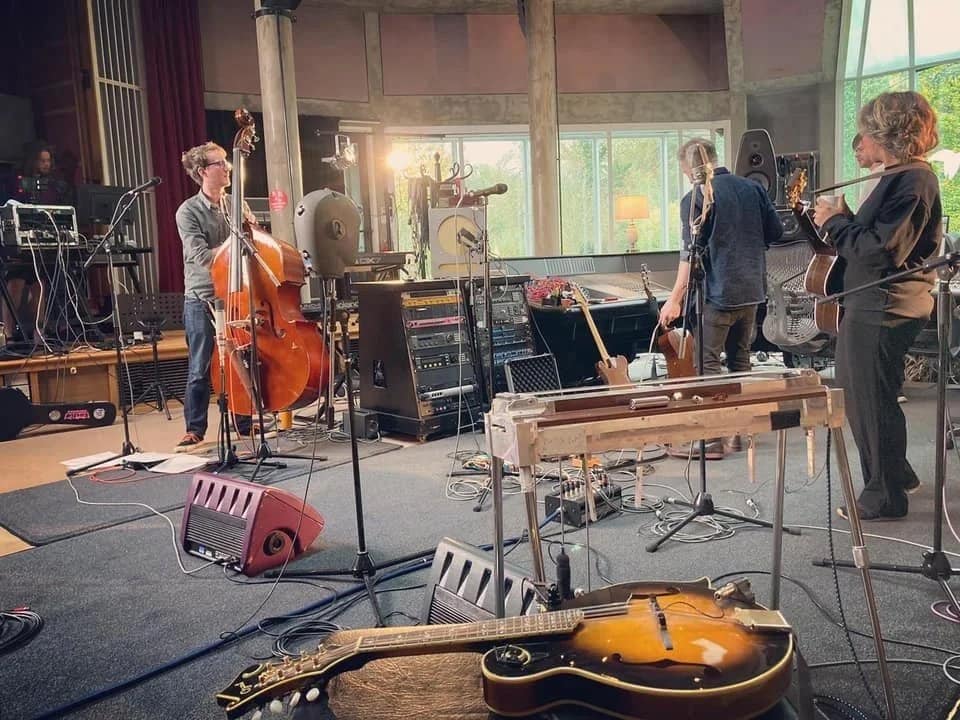
I treat tuning locations differently: studio, rehearsal, and stage each demand choices about tools and process. A Roadie or Peterson can save a set — but only if you know when to rely on a tuner and when to trust the ear.
I’ve used handheld tuners, studio racks and automatic tuners on stage; this section advises which tools work best for each environment and why I trust some over others. In studio I prefer a stable electronic tuner for lap steel or a Peterson tuner in a rack for absolute reference, accepting time overhead. On stage I lean to a Roadie tuner or quick hand-held unit, balancing speed against noisy interference. I keep a tunings database and backup strings; I also train my ear for pitch drift when tools fail.
Why: Why Choose One Tuning Over Another?
Harmonic Reasons: Intervals, Voicings & Open Strings

I choose tunings by their harmonic consequences, so this subchapter explains why interval layouts matter. Open strings shape harmony in lap steel more than on fretted guitars — understanding interval layout is the key to unlocking voicings. From my transcriptions of solos and comping I’ve seen how intervals in C6 produce compact sixths and triads that yield specific C6 chord voicings and unique lap steel chord shapes.
I explain usable advantages—easy cluster voicings, travel-free open-string drones—and limitations—restricted linear runs, and voice-leading tradeoffs compared to standard guitar. This is a pragmatic lap steel harmonic overview: practical reasons to pick C6 or A6 vs open G/D or D6, grounded in playability, voicing availability, and genre fit. My aim: give clear ‘why’ criteria so you can choose tunings by harmonic consequence, not myth, ever.
Practical Trade-offs: Playability vs Range vs Genre

In workshops I often guide players away from ‘everything, everywhere’ tunings and toward pragmatic choices; here I explain the real trade-offs I’ve observed on gigs. Do you want solo range, easy chords, or stylistic authenticity? You usually can’t have all three — here’s how to prioritize.
I weigh playability (how readily I make common shapes), range (low bass and high melody reach), and genre fit (Hawaiian, country, jazz). In tuning comparison of common lap steel tunings I find open chord tunings favour slide idiom and quick accompaniment but limit extended voicings; C6/A6 expand harmony and soloing yet demand familiarity. For tuning for beginners I recommend picking the primary need—then accept limits or add a second neck. My point: conscious compromise beats indecision on stage. Test choices during rehearsal and gigs.
How: Step-by-Step Tuning Guide
Basic Step-by-Step: Tuning a 6-String Lap Steel
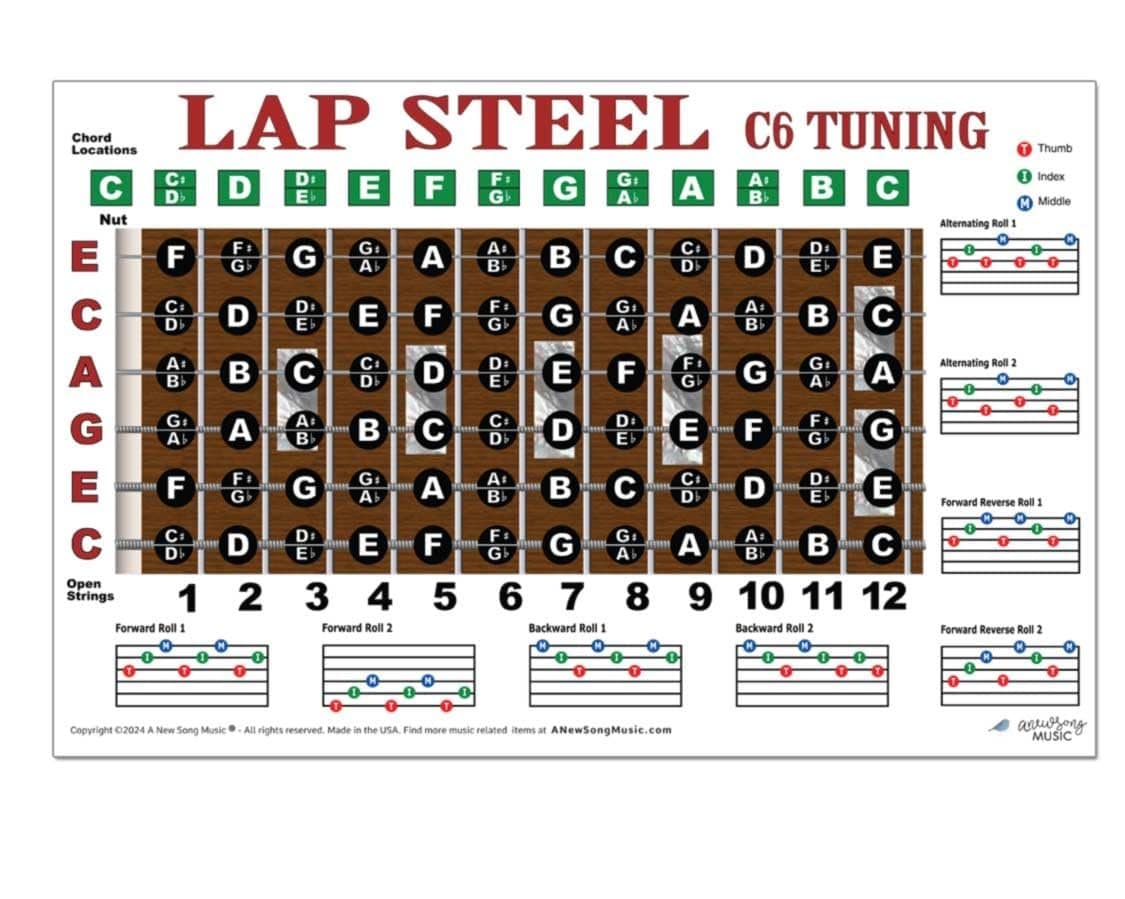
As the routine in the How section, I start beginners on a 6-string lap steel with the same basic steps I use on instruments — it’s fast, repeatable, and designed to stay stable through a gig. A reliable 6-string tuning routine reduces tuning crashes during performance; here’s the exact order I use.
First, tune the lowest string to pitch, then move sequentially upward (6→1) checking against a chromatic tuner. Lock rough pitches, stretch strings gently, then re-tune low-to-high. Check fretted/slide intonation at common positions and adjust saddle or tuning as needed. I recommend a pedal or clip tuner and a printed lap steel tuning chart for quick reference. This method is efficient, but not foolproof: string age, gauge choice, and bridge setup change results, and alternate orders can suit multi-neck rigs. Use this as a baseline for how to tune lap steel, particularly 6-string lap steel tuning, and adapt with experience as part of your practical tuning guide.
Using Tuners & Tools (Peterson, Roadie, Apps)

In this How: Step-by-Step Tuning Guide I explain which tuners and tools actually help me get reliable lap‑steel pitches. Not all tuners are equal for lap steel — some give misleading readings if you don’t understand their settings. I’ve compared Peterson tuner, Roadie tuner and mobile apps across noisy stages; my takeaway: a Peterson’s strobe accuracy wins when accuracy matters, the Roadie tuner speeds repeatable retunes and its tunings database is handy, and apps are great for quiet practice.
Consider limitations: Petersons cost and menu depth, Roadie’s reliance on string vibration can struggle with dead strings, and apps suffer in noisy venues unless using a contact mic or pickup. Practically, I use Peterson for gigs, Roadie for quick changes, apps for learning and reference. This section shows what, when, how.
Practical Tips: Stretching, Checking Intonation, Retuning
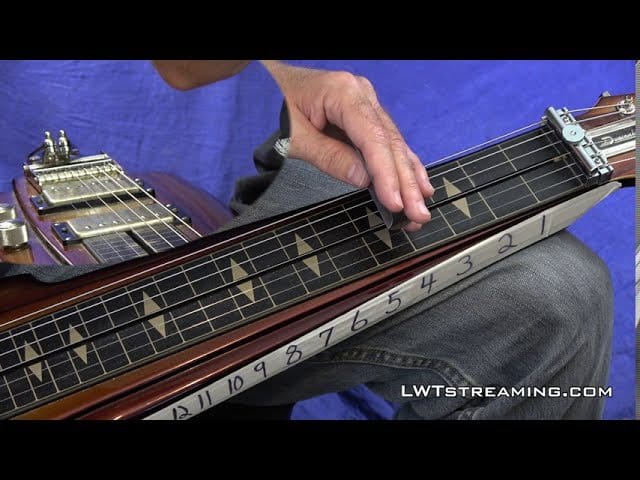
A quick pre-play stretch and an intonation check can keep your lap steel stable through temperature swings and long sets. I start every session with measured string stretching, then verify open-string pitch and fretless intonation across target scale positions.
In this How: Step-by-Step Tuning Guide subchapter I explain practical checks that fit any lap steel setup: peg tightening, tuned-by-ear cross-checks, and using chromatic tuner for scale length intonation confirmation. I teach students to weigh benefits—faster stability and fewer mid-set retunes—against limits: heavy stretching can wear strings and retunes affect action.
Tuning for beginners, matching string gauges for lap steel to your tuning improves hold overall; experienced players should monitor micro-adjustments during temperature changes. Concise, hands-on steps I use and trust.
Tuning Examples & Charts (Hands-on Examples)
C6 Examples: Tuning, Intervals & Sample Voicings
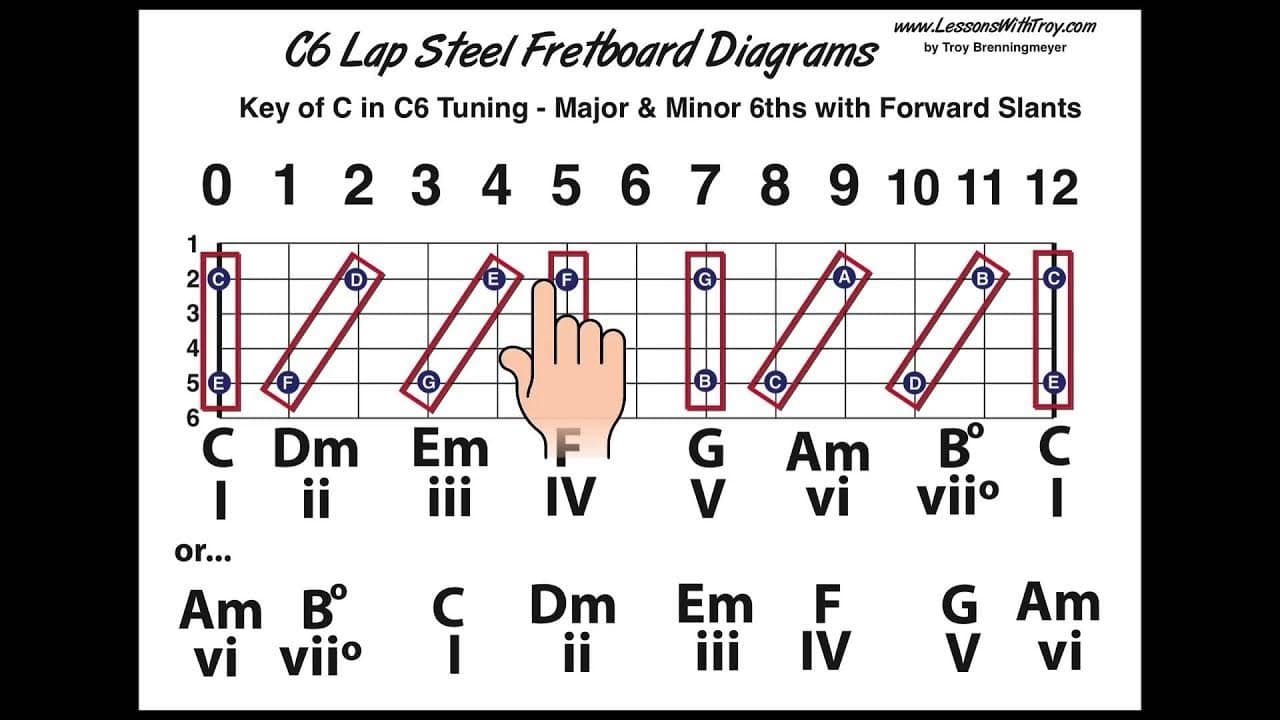
I use C6 daily in lap steel teaching; these example voicings are ones I hand students first because they offer rich harmony with minimal movement. C6 gives you jazz-flavored chords and Hawaiian flavors with just a few familiar patterns—here are the patterns I teach first. How I approach this: start with C6 tuning (C-E-G-A-C-E), check intervals in C6 — major third and sixth — then map three practical shapes: open C6 chord voicings, movable 1-3-6 triad, and a dominant 7 shading for turnarounds.
In a beginner C6 lesson I demonstrate fingering, bar placement, and common interval leaps. Critically, these voicings trade extended range for simplicity; you’ll sacrifice some single-note reach but gain rich harmonic roles. This subchapter supplies hands-on charts and immediate shapes you can play and adapt. Use C6 chord voicings as a bridge between genres while keeping technique accessible today.
A6 Examples: Tuning Uses & Chord Shapes
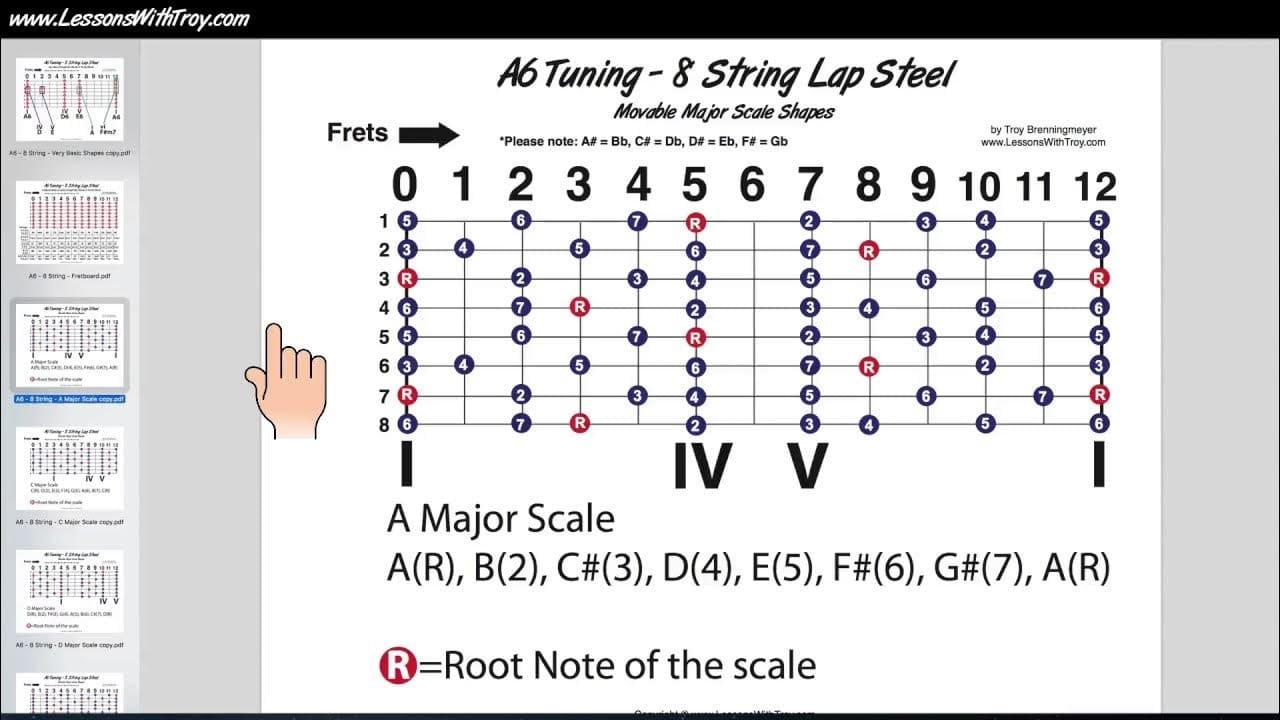
In Tuning Examples & Charts (Hands-on Examples) I show how A6 functions practically. A6 is my go‑to when I need brighter open‑string colors — these chord shapes are the practical voicings I’ve used to cut through mixes. A6 is brighter and punchier than C6 — when you need the steel to sit on top of a mix, here’s how to voice it.
How I approach it: tune to my A6 setup, then voice major triads with the added sixth on upper strings for clarity; use partial bars across two or three strings for movable voicings; employ shell voicings and triads for tuning for jazz lap steel; keep open drones and double‑stops for tuning for country steel. Benefits: clarity and cut. Limits: less low‑end than C6, requires careful muting, and chord extensions are trickier—so I balance voicing choice with song role.
Open G & Open D: Slide-Friendly Charts
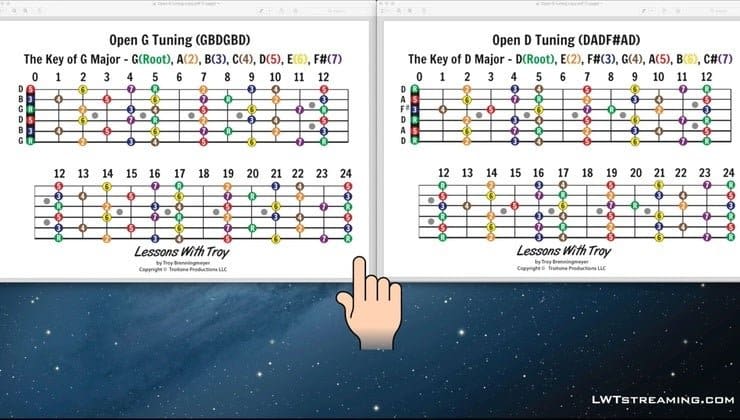
I’ve used open G and D for open chord tunings and roots-in-front arrangements; the charts here are distilled from common slide licks that work in many songs. Open tunings make single-bar chords immediate — but which open tuning best suits your slide technique? I answer by showing how to read and apply charts: label strings, mark root positions, map movable major/minor shapes, and list three go-to licks per tuning.
Practically, Open G tuning and Open D tuning (DADF#BD) favor different ranges—G gives beefier low end; D sits brighter and easier for capo shifts. I note limitations: drone clutter, fewer extended voicings, and setup needs (action, intonation). In Tuning Examples & Charts (Hands-on Examples) this subchapter supplies the how: quick-reference charts, execution tips, and trade-offs so you can pick and apply the tuning that fits your slide goals and iterate deliberately.
D6 & Variations: Voicings and When to Use Them

As part of the Tuning Examples & Charts (Hands-on Examples) section, I show how D6 variations function among common lap steel tunings, when to pick them practically.
I favor D6 tuning (DADF#BD) for ballads and instrumental colors because it simplifies major-six voicings and stacked fourths. D6 offers unique interval colors; learn when that color is exactly what a song is asking for. How I use it: target open drones, slide between 6th and major triads, and add9 or sus shapes for airier tones. Compared with C6 or A6, D6 gives lower D bass and distinct F# leading tones, but it narrows some chord-fingerings and can limit upper-range chords on 6-string necks. try voicings shown in tuning examples: open D major, D6 spread, inversions. I recommend A/B testing tracks to judge whether D6’s interval palette serves the arrangement and mix too.
Beginner Recommendations & Setup Tips
Best Starter Tuning: Why Many Begin with C6
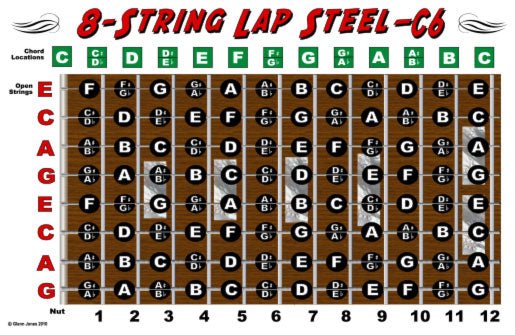
Almost all my students benefit from C6 tuning’s balance of chords and melodic options — here’s why I recommend it as a first tuning. C6 isn’t arbitrary — it’s a practical compromise between harmony and single-note playability that’s ideal for beginners.
Who should pick it? I point it to new players, guitarists transitioning to lap steel, and students focused on Hawaiian, country styles because it gives usable C6 chord voicings and melodic intervals.
In my beginner C6 lesson I emphasize open-string shapes, simple scales, and tuning for beginners. Objectively, C6 sacrifices some open-g slide voicings and low-range drone power, so if you aim exclusively for open-G country licks or heavy bass lines, consider alternatives. As part of Beginner Recommendations & Setup Tips, C6 reliably speeds progress for most beginner players.
Setup & Gear: Strings, Gauge & Intonation for Beginners

I’ve helped beginners choose strings and set intonation so their instruments behave predictably; this guidance avoids the common mistakes that discourage new players. In Beginner Recommendations & Setup Tips I focus on who benefits: new players, owners of 6- or 8-string necks, and teachers. The right string gauge and a small intonation tweak can turn a frustrating beginner experience into one that’s inspiring and musical.
I recommend starting with medium-light to medium string gauges for lap steel—balance between playability and tone—and explain trade-offs: heavier strings increase sustain but raise tension and action. Practical lap steel setup includes checking scale length intonation and minor saddle shifts; expect compromises across strings. Lap steel harmonic overview helps you confirm tuning stability. My approach is pragmatic: test, measure, and adjust, not assume one solution.
Multi-neck & Extended Options for Growth
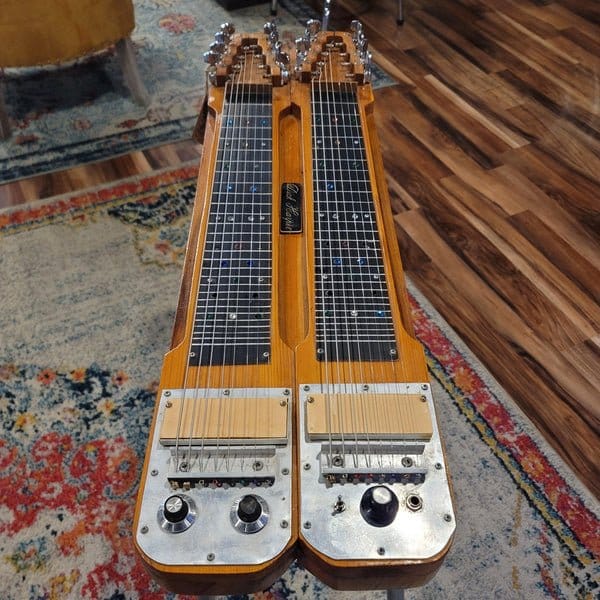
I recommend multi-neck options only after students master single-neck basics; as the Who in Beginner Recommendations & Setup Tips, it’s for players needing tonal variety or extended range. I explain practical trade-offs: double neck lap steel tuning and triple neck tuning offer quick access to different voicings but add weight, setup complexity, and intonation headaches. An 8-string lap steel tuning can give richer chords yet requires different string gauges and playing ergonomics.
Before you invest in another neck, ask: will it solve a musical problem or just create a new one? I advise matching goals—studio versatility, live switching, or specific repertoire—against budget, transport, and maintenance. Often the best choice is patient mastery of standard lap steel tuning and retuning routines; upgrade only when necessity, not novelty, drives clearer musical outcomes.
FAQs
What are the standard pitch layouts for C6, A6, Open G/D and D6 on a 6-string lap steel?
– C6: C–E–G–A–C–E — a versatile tuning for Western swing, jazz and Hawaiian styles.
– A6: A–C♯–E–F♯–A–C♯ — bright, similar intervals to C6 but pitched down.
– Open G: D–G–D–G–B–D — classic for blues/folk slide voicings.
– Open D: D–A–D–F♯–A–D — deeper open tuning often grouped with Open G as “Open G/D” options.
– D6: D–F♯–A–B–D–F♯ — adds the sixth for melodic chord possibilities.
Use these string orders when tuning from the lowest/ thickest string to the highest/ thinnest string.
How do I practically tune between these tunings while playing or recording?
– Keep multiple pre-tuned instruments or necks, or
– Use labeled peg positions and tune quickly between songs (start from lowest string upward).
For studio work, tune slowly and re-check intonation at fretted/slide positions; temper changes can shift action and intonation on lap steel due to different string tension.
What setup and string choices work best across these tunings?
Which chord shapes and melodic patterns should I learn first in each tuning?
– C6/A6: learn the I–IV–V shapes and common major6 voicings; practice major scale and major6 arpeggios.
– Open G/Open D: learn full open chord bars (one-bar majors) and common bottleneck riffs that move single-note melodies over drone strings.
– D6: practice major and major6 shapes, plus simple pentatonic runs that exploit the added sixth.
Work on sliding between chord positions cleanly and combining melody on higher strings with drone bass on lower strings.
What practical tips help get useful tones and consistency when using these tunings?
Is C6 the Best Starter Tuning?

I often get asked in FAQs whether C6 tuning is the best starter. My short answer to new players is usually ‘yes’ for practical reasons; in this FAQ I explain nuances from my teaching experience. Yes — often — but here’s when you might choose something else from the outset. I recommend C6 because it balances melody and chords, simplifies major/minor shapes, and maps to a beginner C6 lesson.
How I guide students: set a 6-string to C6, tune with a chromatic tuner, set intonation, learn three chords and two melodic patterns. However, players aiming for blues slide or guitar transposition may prefer Open G or A6. This entry explains practical trade-offs and helps tuning for beginners decide more rationally.
Can I Use Standard Guitar Strings or Do I Need Specific Gauges?

FAQs: can I use standard guitar strings or do I need specific gauges? I’ve seen players adapt standard strings and problems follow — I’ll explain what works and why I recommend specific gauges.
You can get by with standard strings, but the right gauge makes intonation and tone more reliable.
How I choose: match tension to scale and tuning. String gauges for lap steel must address scale length intonation — long scales and low C6/A6 need heavier strings; short scales and high tunings suit lighter sets. Mixing heavier wound basses with lighter trebles balances tone without custom set.
Trade-offs: heavier gauges raise action and may need nut/saddle work in your lap steel setup; lighter gauges risk reduced sustain and fret-out.
Which Tuners or Apps Work Best for Lap Steel?

Some tuners are geared to guitar habits and can mislead a lap steel player — learn which features matter for steel tuning. I’ve tested popular tuners in studios and on stage; my recommendations reflect performance conditions rather than marketing claims. For lap steel I prioritize true-strobe accuracy, adjustable temperaments, and contact pickup input.
Practically, a Peterson tuner offers strobe precision and temperament options but is pricier; a Roadie tuner automates fast on-stage changes yet depends on machine-fit and string-slack setup. For quick checks, apps with a robust tunings database are handy, but phone mics struggle in loud venues — use a piezo/contact or an electronic tuner for lap steel when possible. Balance accuracy, speed, and workflow; verify intonation by ear.
Conclusion
A few consistent habits — one starter tuning, a reliable setup, and a small set of voicings — will take you farther than mastering every tuning at once. After years of playing and teaching with lap steel, I close with the actionable summary I hand out to students before the gig. I covered who uses each tuning, the core common lap steel tunings (C6, A6, Open G/D, D6), where to tune and lap steel setup, and how to tune step‑by‑step with tuners and lap steel tuning chart.
For tuning for beginners I recommend C6 as starter and focus on voicings and intonation. I also acknowledge trade‑offs: tonal goals, playability and setup matter, and mastery grows through gigs, not mere shortcuts.